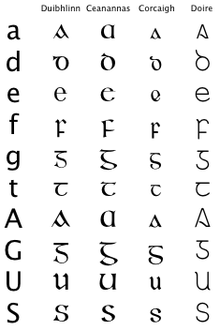Plé:Cló Gaelach
le haistriú
Teimpléad:Infobox Writing system
The term Gaelic type, a translation of the Irish phrase cló Gaelach (pronounced Teimpléad:IPA-ga), refers to a family of insular typefaces devised for writing Irish and used between the 16th and 20th centuries. Sometimes, all Gaelic typefaces are called Celtic or uncial, though most Gaelic types are not uncials. In Ireland the term cló Gaelach is used in opposition to the term cló Rómhánach, in English 'Roman type'. Gaelic type is sometimes called Irish type. The "Anglo-Saxon" types of the 17th century are included in this category because both the Anglo-Saxon types and the Gaelic/Irish types derive from the Insular manuscript hand.
Tréithe
[athraigh foinse]
Besides the 26 letters of the Latin alphabet, Gaelic typefaces must include all vowels with acute accents (Áá Éé Íí Óó Úú) as well as a set of consonants with dot above (Ḃḃ Ċċ Ḋḋ Ḟḟ Ġġ Ṁṁ Ṗṗ Ṡṡ Ṫṫ), and the Tironian sign et "⁊", used for agus 'and' in Irish. Gaelic typefaces also often include insular forms of the letters s and r, and some of them contain a number of ligatures used in earlier Gaelic typography and deriving from the manuscript tradition. Lower-case i is drawn without a dot (though it is not the Turkish dotless ı), and the letters d, f, g, and t have insular shapes. Many modern Gaelic typefaces include Gaelic letterforms for the letters j, k, q, v, w, x, y, and z, and typically provide support for at least the vowels of the other Celtic languages. They also distinguish between & and ⁊ (as did traditional typography), though some modern fonts replace the ampersand with the Tironian note ostensibly because both mean 'and'.
Bunús
[athraigh foinse]The Irish uncial alphabet originated in medieval manuscripts as an "insular" variant of the Latin alphabet. The first Gaelic typeface was designed in 1571 for a catechism commissioned by Elizabeth I to help convert the Irish Roman-Catholic population to Protestantism.
Úsáid
[athraigh foinse]Typesetting in Gaelic script remained common in Ireland until the mid-20th century. Gaelic script is today used merely for decorative typesetting; for example, a number of traditional Irish newspapers still print their name in Gaelic script on the first page, and it is also popular for pub signs, greeting cards, and display advertising. Edward Lhuyd's grammar of the Cornish language used Gaelic-script consonants to indicate sounds like [ð] and [θ].
Gaelic script in Unicode
[athraigh foinse]Unicode treats the Gaelic script as a font variant of the Latin alphabet. A lowercase insular g (ᵹ) was added in version 4.1 as part of the Phonetic Extensions block because of its use in Irish linguistics as a phonetic character for [ɣ]. Unicode 5.1 (2008) further added a capital G (Ᵹ) and both capital and lowercase letters D, F, R, S, T, besides "turned insular G", on the basis that Edward Lhuyd used these letters in his 1707 work Archaeologia Britannica as a scientific orthography for Cornish.
- Ᵹ ᵹ Insular G (U+A77D, U+1D79)
- Ꝺ ꝺ Insular D (U+A779, U+A77A)
- Ꝼ ꝼ Insular F (U+A77B, U+A77C)
- Ꝿ ꝿ Turned insular G (U+A77E, U+A77F)
- Ꞃ ꞃ Insular R (U+A782, U+A783)
- Ꞅ ꞅ Insular S (U+A784, U+A785)
- Ꞇ ꞇ Insular T (U+A786, U+A787)
Samplaí
[athraigh foinse]

Chuaigh bé mhórshách le dlúthspád fíorfhinn trí hata mo dhea-phorcáin bhig,
Ċuaiġ bé ṁórsháċ le dlúṫspád fíorḟinn trí hata mo ḋea-ṗorcáin ḃig,
meaning "A greatly satisfied woman went with a truly white dense spade through the hat of my good little well-fattened pig".
The second sentence (bottom line) reads:
Duibhlinn/Ceanannas an cló a úsáidtear anseo,
meaning "Duibhlinn/Ceannanas is the font used here".
The second sentence uses the short forms of the letters r and s; the first uses the long forms.
Gailearaí
[athraigh foinse]-
Gaelic script used on an information plaque outside City Hall, near Dublin Castle.
-
Gaelic script on the gates of the Pontifical Irish College in Rome.
-
An cló Gaelach ar chloch chinn i gCondae Chiarraí.
-
An cló ar shéadchomhartha Éireannach.
Foinsí agus Nascanna Seachtracha
[athraigh foinse]- Michael Everson's History and classification of Gaelic typefaces, 2000-06-19
- Michael Everson's Celtscript range of fonts
- Brendan Leen's Four centuries of printing in the Irish character, Cregan Library, St Patrick's College, Drumcondra
- Vincent Morley's An Cló Gaelach (in Irish)
- Mícheál Ó Searcóid's The Irish Alphabet, an article on the origin, history and present-day usage of the Irish typeface, 1990
- Mathew D. Staunton's Trojan Horses and Friendly Faces: Irish Gaelic Typography as Propaganda. La revue LISA. ISSN 1762-6153. Vol. III; n°1. 2005.
- Bunchló GC, a Gaelic modern minuscule font in Unicode.
- Gadelica, a Gaelic traditional minuscule font in Unicode.
- More information about Gaelic fonts




